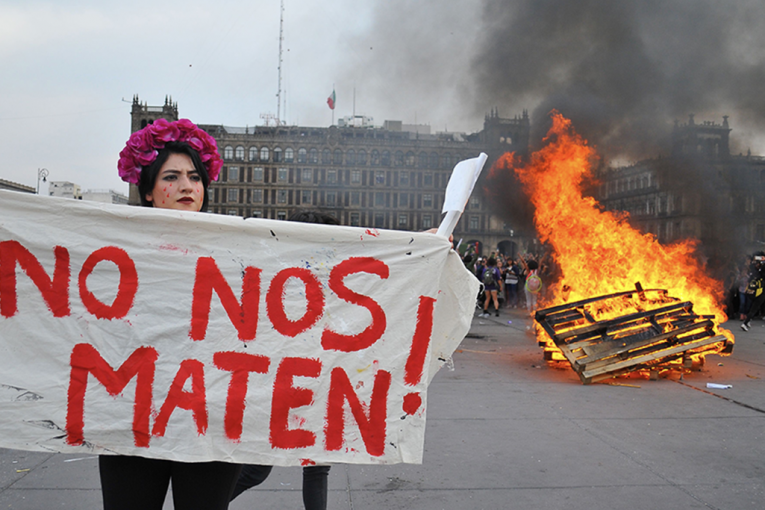

By Alexa Castruita
MEXICO CITY— Maria de Jesus Jaime Zamudio. Ingrid Escamilla Vargas. Debanhi Susana Escobar Bazaldúa. These names represent the latest of growing violence against Mexican women in the past few years—one that has been the fuel for protests calling upon the Mexican government to put in place stronger protections for vulnerable women across the nation, leading to clashes and social unrest between protestors and government officials. Although nothing new in the field of protests within Mexico against patriarchal standards, these protests have presented a virtually unseen front in contemporary Mexican society.
Femicide, the term used for the violence faced by these women, is defined by the murder of women on the basis of their sex. Violence against women is not a novelty in the history of Mexican society, nor any society, but its growth over the last several years has become a deep worry for women everywhere.
According to the Mexico Peace Index, “femicides…also rose significantly in this period, from 427 reported victims in 2015 to 1,004 in 2021, marking a 135 percent increase.” It is worth noting that these are only deaths that have been properly investigated and logged as femicides, not all homicides of females.
Another finding from the MPI concludes that “victims of femicide are more likely to be minors (those under 18 years of age), accounting for 11.6 percent of all victims.” The targeting of girls and young women is becoming a bigger point of worry for the parents and families sending their children out into the world each and every day.
The report also presents that these increasing rates of femicide are “in line…with increases in recorded cases of family violence and sexual assault in Mexico,” displaying a possible correlation for the motives behind these murders.
In 2016, 19-year-old Maria de Jesus Jaime Zamudio was killed by a professor and a fellow classmate at the National Polytechnic Institute (IPN), where Jaime Zamudio was studying engineering. In the months following her death, activists, including her mother, rallied in her memory and her name in support for stronger protections for victims to prevent more of these crimes from occurring. As a response, officials at the IPN admitted that they did have “ineffective instruments to protect victims of gender violence.”
Despite protests commemorating Zamudio’s and countless other women’s stories, the killings kept coming and coming.
In Feb. 2020, 25-year-old Ingrid Escamilla Vargas was murdered by her 46-year-old partner, Erik Francisco Robledo Rosas, after a dispute ensued between the two. Escamilla Vargas was stabbed and dismembered by Robledo Rosas in her home and pictures of her body were leaked and distributed amongst public social media platforms.
This past March, activists and citizens alike gathered in Mexico City in protest of growing femicides. Protestors chanted “¡Ni una mas!,” translating to “Not one more!” in demands for a termination of the various female deaths attributed to gender-based violence reported every day.
And just one month later, in April of this year, 18-year-old Debanhi Susana Escobar Bazaldúa went missing and was later found dead in Nuevo Leon. She had been out with her friends, but when they entered into a dispute, Escobar Bazaldúa left with a driver her friends had provided her with. Her family learned of her disappearance and reported it to police officials. When Escobar Bazaldua’s body was found, autopsy reports presented that she had experienced both physical and sexual abuse before she had been killed.
These three women represent only a sliver of the victims of femicide not just in Mexico, but of a growing population of women facing violence all across Latin America..
As for how the Mexican government has reacted in the wake of these issues, Mexican president Andrés Manuel López Obrador, also known as AMLO, played down the severity of these cases and of the protests themselves. López Obrador stated that protests were staged to paint his administration in a negative light and that the femicides were to be blamed on Mexican political liberals.
The government, instead of pushing out concrete policies to bring an end to the murders, published a set of “rules” called “Ten Commandments vs. Violence Against Women” that presented no actual legal approaches to ending the wave of crimes against women in the nation.
With growing pressures on the government and a very true reality of its own long-standing corruption, Mexican women are not too keen on relying on the government’s support in this matter.
Jaime Zamudio’s mother, Yesenia Zamudio, called out the Mexican president during one of the protests commemorating her daughter and other victims, questioning, “How are they going to believe us if the most important, powerful man, who has the highest level of popularity in the history of the presidents of Mexico, does not believe us?”